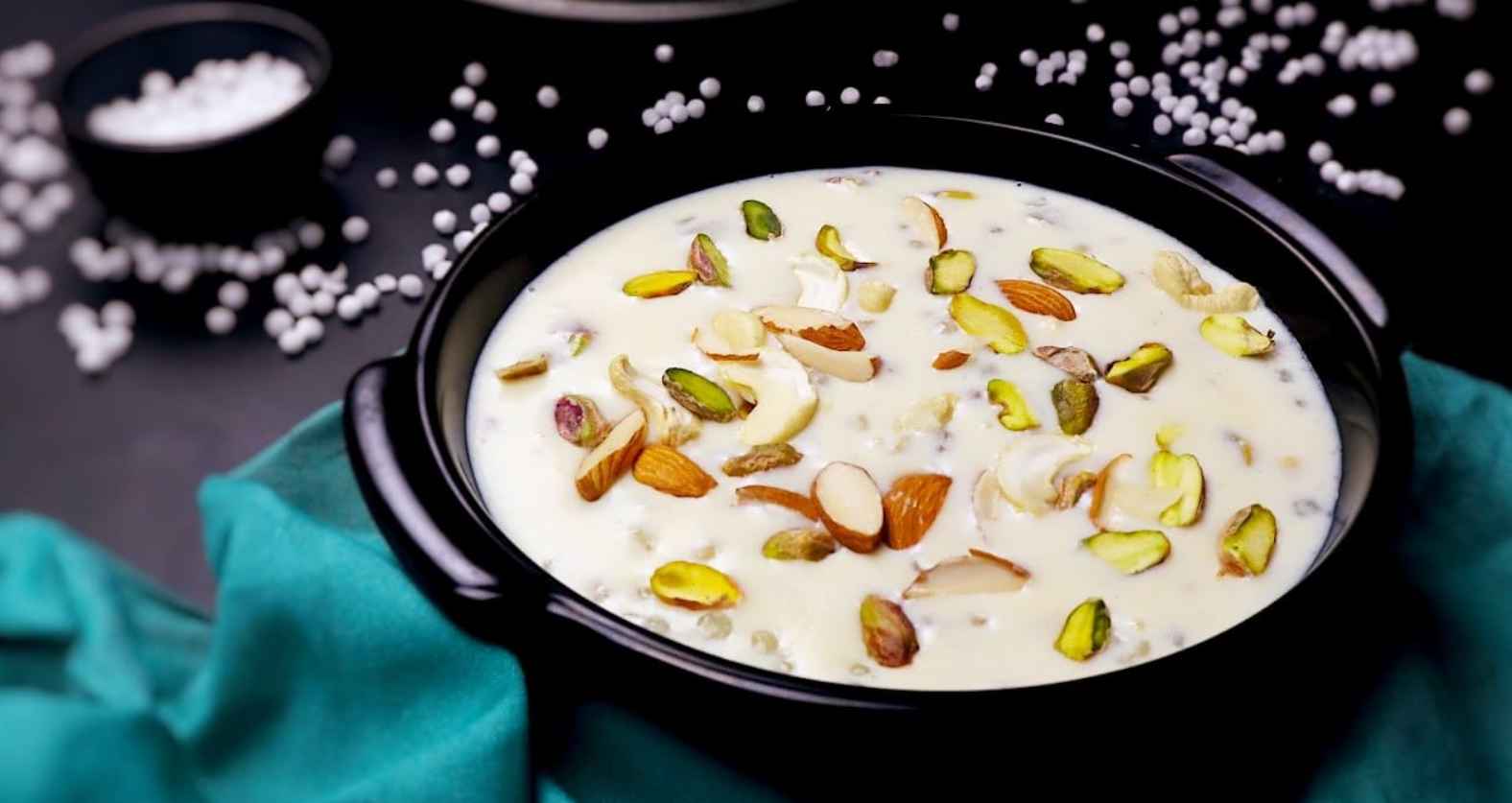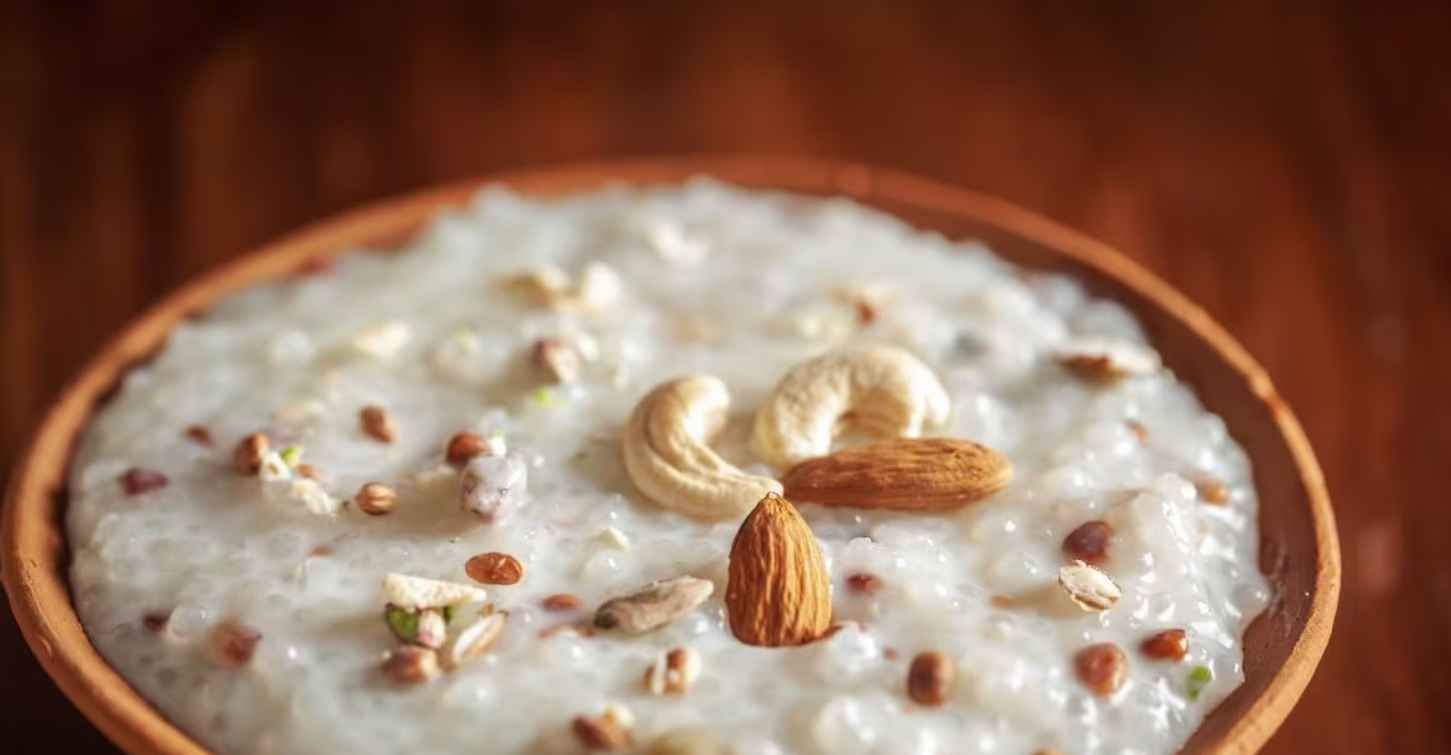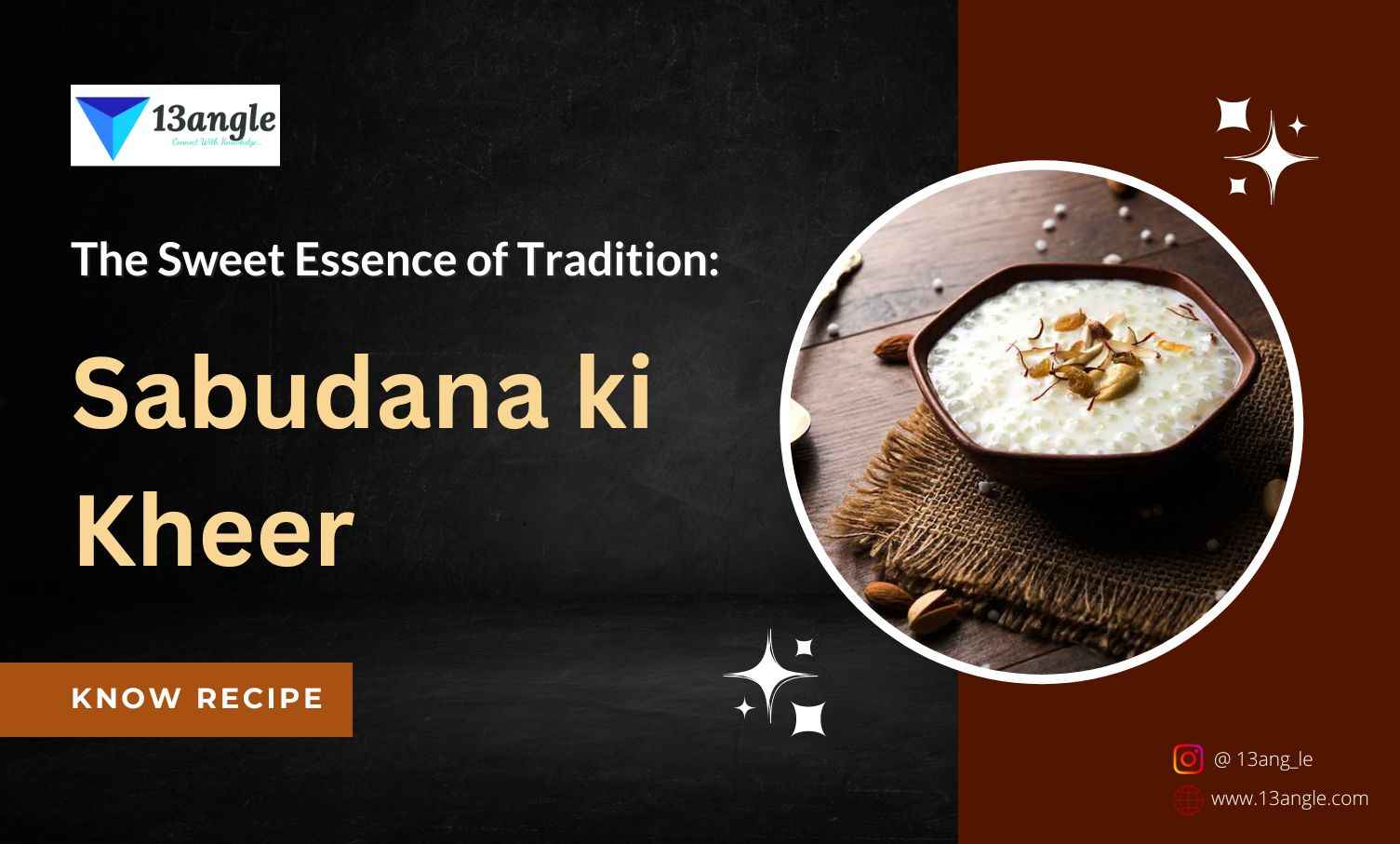- Umang Sagar
- Cuisine
The Sweet Essence of Tradition: Sabudana ki Kheer

Introduction
Sabudana ki kheer, also known as sago pudding, is a delectable Indian dessert that holds a special place in the hearts of those who indulge in its creamy goodness. This delightful sweet dish brings together the humble tapioca pearls, commonly known as sabudana, with the richness of milk and the subtle aroma of cardamom. With a history deeply rooted in Indian culinary traditions, sabudana ki kheer has evolved into a popular and cherished treat, often prepared during festivals, celebrations, and fasting periods.
As a versatile ingredient, sabudana takes center stage in this kheer, offering a unique texture and delightful taste that captivates the palate. The dessert’s ability to strike the perfect balance between sweetness and comforting creaminess makes it an all-time favorite among both the young and the old.
The preparation of sabudana ki kheer involves the slow cooking of the soaked tapioca pearls in milk, allowing them to turn translucent and soft. The addition of sugar and cardamom further enhances the flavor profile, creating an indulgent experience that leaves a lasting impression.
Whether served hot to provide comfort during cold winter nights or chilled for a refreshing summer treat, sabudana ki kheer remains a symbol of love, warmth, and togetherness in Indian households. Its cultural significance and culinary appeal have also spread to other parts of the world, making it a delightful dessert appreciated by those with a penchant for Indian cuisine.
Join us on a culinary journey as we delve into the intricacies of making sabudana ki kheer, exploring the heritage and flavors that make this timeless dessert a treasured part of Indian gastronomy.
History

The history of sabudana ki kheer, also known as sago pudding, is deeply rooted in Indian culinary traditions and cultural practices. While the exact origins of this dessert are not well-documented, it has been a popular and cherished sweet dish in India for centuries.
Sabudana, which is made from the starch extracted from the pith of the sago palm stems or cassava roots, has been used as a food source in various cultures around the world for centuries. In India, it has been consumed for its energy-rich properties and versatility in cooking. It is a common ingredient in various dishes, especially during fasting periods when certain grains and lentils are avoided, making sabudana an excellent alternative.
The practice of making sabudana ki kheer likely evolved over time, combining the traditional use of sabudana with other Indian culinary techniques and flavors. Kheer, which is a type of milk-based pudding, is a classic Indian dessert enjoyed across the country in various regional variations. It is considered a comfort food and is often prepared during festivals, celebrations, and religious occasions.
The combination of sabudana and milk to create sabudana ki kheer offers a delicious, creamy, and nourishing dessert option, particularly during fasting periods like Navratri, where specific food restrictions are followed. The dish is sweetened with sugar or jaggery and flavored with spices like cardamom to enhance its taste and aroma.
While the exact historical origin of sabudana ki kheer remains unclear, it has become an integral part of Indian cuisine and culture over time. The recipe has been passed down through generations, and it continues to be cherished and prepared with love in households across India and beyond. With the passage of time, sabudana ki kheer has also gained popularity in other parts of the world where Indian cuisine is appreciated, showcasing its enduring appeal and cultural significance.
Origin Of Sabudane Ki Kheer Recipe

The exact origin of sabudana ki kheer is not well-documented, but it is believed to have its roots in India. The dish likely evolved over time as a combination of the traditional use of sabudana and the culinary practices of making kheer, a milk-based pudding.
Sabudana, which is made from tapioca pearls derived from the pith of sago palm stems or cassava roots, has been used as a food source in various cultures for centuries. In India, sabudana has been consumed for its energy-rich properties and versatility in cooking. It is particularly valued during fasting periods when certain grains and lentils are avoided, making sabudana an excellent alternative to fulfill nutritional requirements.
Kheer, on the other hand, is a classic Indian dessert made by slow-cooking rice or other ingredients in milk, sweetened with sugar or jaggery, and flavored with spices like cardamom. Kheer has been a part of Indian culinary traditions for ages and is enjoyed across the country in various regional variations. It is often prepared during festivals, celebrations, and religious occasions, signifying joy, abundance, and auspiciousness.
The combination of sabudana and milk to create sabudana ki kheer likely emerged as a fusion of these two culinary practices. The soft and translucent texture of soaked sabudana blended harmoniously with the creamy consistency of milk, creating a delightful and satisfying dessert.
Over time, the preparation of sabudana ki kheer has been passed down through generations, becoming a cherished part of Indian cuisine and culture. It is prepared and enjoyed in households across the country, particularly during festivals and fasting periods when it holds special significance. With the spread of Indian cuisine and cultural practices to other parts of the world, sabudana ki kheer has also gained popularity beyond India, making it a beloved dessert for those who appreciate the flavours and traditions of this delightful sweet dish.
How To Make Sabudana Ki Kheer

Sabudana ki kheer, also known as sago pudding, is a delicious Indian dessert made with tapioca pearls, milk, sugar, and flavoured with cardamom. It’s often enjoyed during festive occasions or as a comforting sweet treat. Here’s a detailed recipe and elaboration on how to make sabudana ki kheer:
Ingredients:
- 1/2 cup sabudana (tapioca pearls)
- 4 cups milk
- 1/2 cup sugar (adjust to taste)
- 1/4 teaspoon cardamom powder
- A pinch of saffron strands (optional)
- 1 tablespoon ghee (clarified butter)
- 2 tablespoons chopped nuts (almonds, cashews, pistachios)
- Raisins for garnish
- Water for soaking sabudana
Instructions:
Soak the Sabudana: Rinse the sabudana under running water until the water runs clear. Then, soak the sabudana in enough water to cover them completely for about 2-3 hours. They should become soft and swell during this time. After soaking, drain any excess water.
Boil the Milk: In a thick-bottomed pan, bring 4 cups of milk to a boil on medium heat. Stir the milk occasionally to prevent sticking to the bottom of the pan.
Cook the Sabudana: Once the milk starts boiling, add the soaked sabudana to it. Stirring continuously, cook the sabudana on medium-low heat until they turn translucent and become soft. It may take around 10-15 minutes. Make sure to stir frequently to avoid sticking.
Add Sugar and Flavor: Now, add the sugar to the pan and continue stirring. Allow the kheer to simmer on low heat for another 5-7 minutes until the sugar dissolves completely. Also, add the cardamom powder and saffron strands at this point to enhance the flavor.
Sauté Nuts: In a separate small pan, heat 1 tablespoon of ghee. Add chopped nuts (almonds, cashews, pistachios) and sauté them until they turn golden brown. Keep some nuts aside for garnishing.
Mix the Sautéed Nuts: Add the sautéed nuts to the kheer and stir them in. This will add a delightful crunch to the creamy texture.
Garnish: Switch off the flame, and your sabudana ki kheer is ready. You can garnish it with a few more chopped nuts and some raisins for added taste and visual appeal.
Serve: Serve the sabudana ki kheer hot or chilled, depending on your preference. It tastes delicious both ways.
Tips:
- While cooking the sabudana in milk, make sure to keep the flame on medium-low to prevent burning or sticking.
- Stir the kheer frequently to ensure even cooking and to prevent lumps.
- If you like your kheer to be thicker, you can reduce the amount of milk or let it simmer for a little longer.
- Adjust the sugar quantity to suit your taste preferences.
- If you want a vegan version, you can use coconut milk or almond milk instead of dairy milk.
Enjoy this creamy and aromatic sabudana ki kheer as a delightful dessert after a meal or as a special treat during festive occasions!
Sabudana Ki Kheer In Festivals And Fasting

Sabudana ki kheer holds a special place during festivals and fasting periods in Indian culinary traditions and cultural practices. Let’s explore why this delectable dessert is so significant during these occasions:
Festivals: During Hindu festivals like Navratri, Shivratri, and Janmashtami, it is common for people to observe fasts as a form of devotion and purification. On these auspicious occasions, certain grains and lentils are avoided, and sabudana becomes a popular and cherished ingredient to include in meals. Sabudana ki kheer, with its creamy texture and sweet taste, is an ideal dessert to offer as a prasad (offering) to deities and share with family and friends during these festive celebrations.
Fasting Food: Sabudana is a preferred choice during fasting periods because it provides a quick source of energy and is easy to digest. It helps sustain individuals through the day when they are abstaining from regular meals. Sabudana ki kheer not only satiates sweet cravings but also offers nourishment and comfort during fasting hours, making it a quintessential part of the fasting menu.
Nutritional Benefits: During fasting, when certain food groups are restricted, sabudana comes to the rescue with its rich carbohydrate content, essential for maintaining energy levels. The milk used in the kheer provides calcium and protein, offering a balanced and nutritious treat during fasting days.
Symbol of Celebration: Festivals in India are occasions of joy, abundance, and togetherness. Sabudana ki kheer, with its luscious taste and creamy texture, embodies the spirit of celebration and is often prepared as a special dessert to mark these occasions. Its presence on the festive menu adds to the joy and festive ambience.
Cultural Significance: In Indian households, food plays a vital role in cultural traditions and customs. Sabudana ki kheer has become ingrained in the cultural fabric, with families passing down the recipe through generations. The preparation and consumption of this dessert during festivals and fasts evoke a sense of continuity, connecting people to their heritage and ancestral practices.
Sabudana ki kheer is not just a dessert but a symbol of devotion, tradition, and celebration during festivals and fasting periods. Its presence on the dining table creates an atmosphere of warmth and togetherness, making it an integral part of these special occasions in Indian households.
Top 13 Interesting Facts About Sabudana Ki Kheer
Name Variations: Sabudana ki kheer is also known by other names, such as “sago kheer” or “tapioca pudding.”
Festive Delight: It is a popular dessert prepared during Hindu fasting festivals like Navratri and Shivratri.
Fasting Tradition: Sabudana is often consumed during fasting periods due to its high carbohydrate content, providing a quick source of energy.
Easy Digestion: Sabudana is gluten-free and easy to digest, making it a suitable option during fasting when certain grains are restricted.
Creamy and Satisfying: Sabudana ki kheer has a creamy texture and rich flavor, making it a comforting and satisfying dessert.
Nutritional Value: It is a good source of carbohydrates, calcium, and iron due to the use of milk and sabudana.
Vegan Adaptation: To make it vegan-friendly, you can substitute dairy milk with coconut milk or almond milk.
Saffron Infusion: Some variations of sabudana ki kheer include saffron strands, adding a delightful golden hue and a subtle fragrance.
Cardamom Aroma: The dish is often flavored with cardamom powder, enhancing its taste and aroma.
Garnishing Options: Traditionally, it is garnished with chopped nuts like almonds, cashews, and pistachios for added crunch and appeal.
Regional Variations: Different regions in India have their own unique ways of preparing sabudana ki kheer, incorporating local flavors and ingredients.
Cooling Dessert: It can be served chilled, especially during hot weather, as a refreshing dessert option.
Global Popularity: Sabudana ki kheer has gained popularity beyond India and is enjoyed by people who appreciate Indian cuisine around the world.



